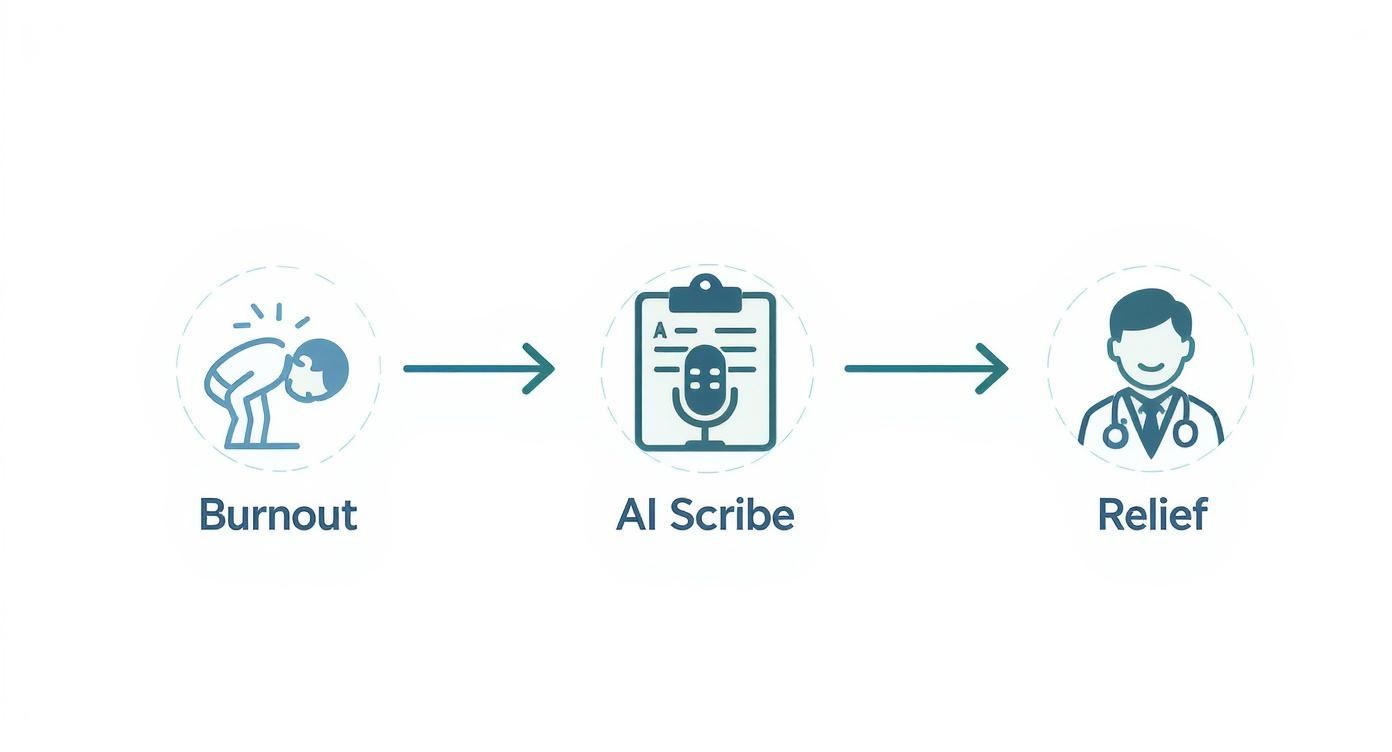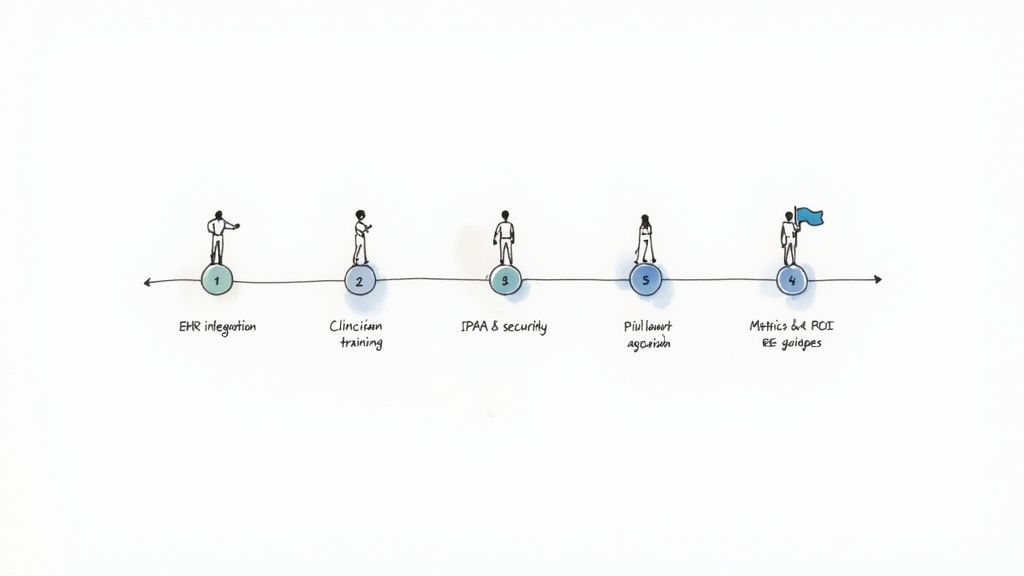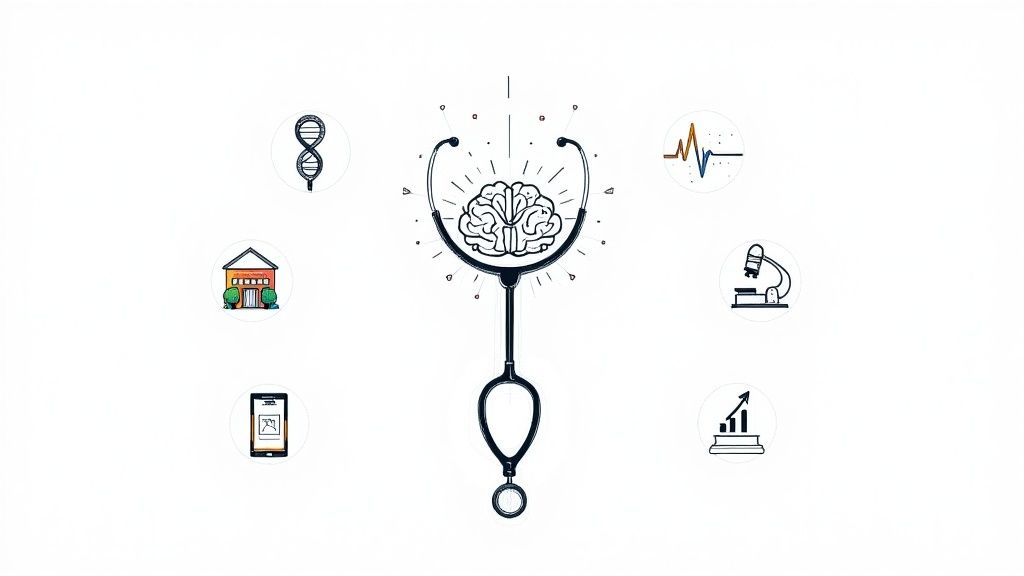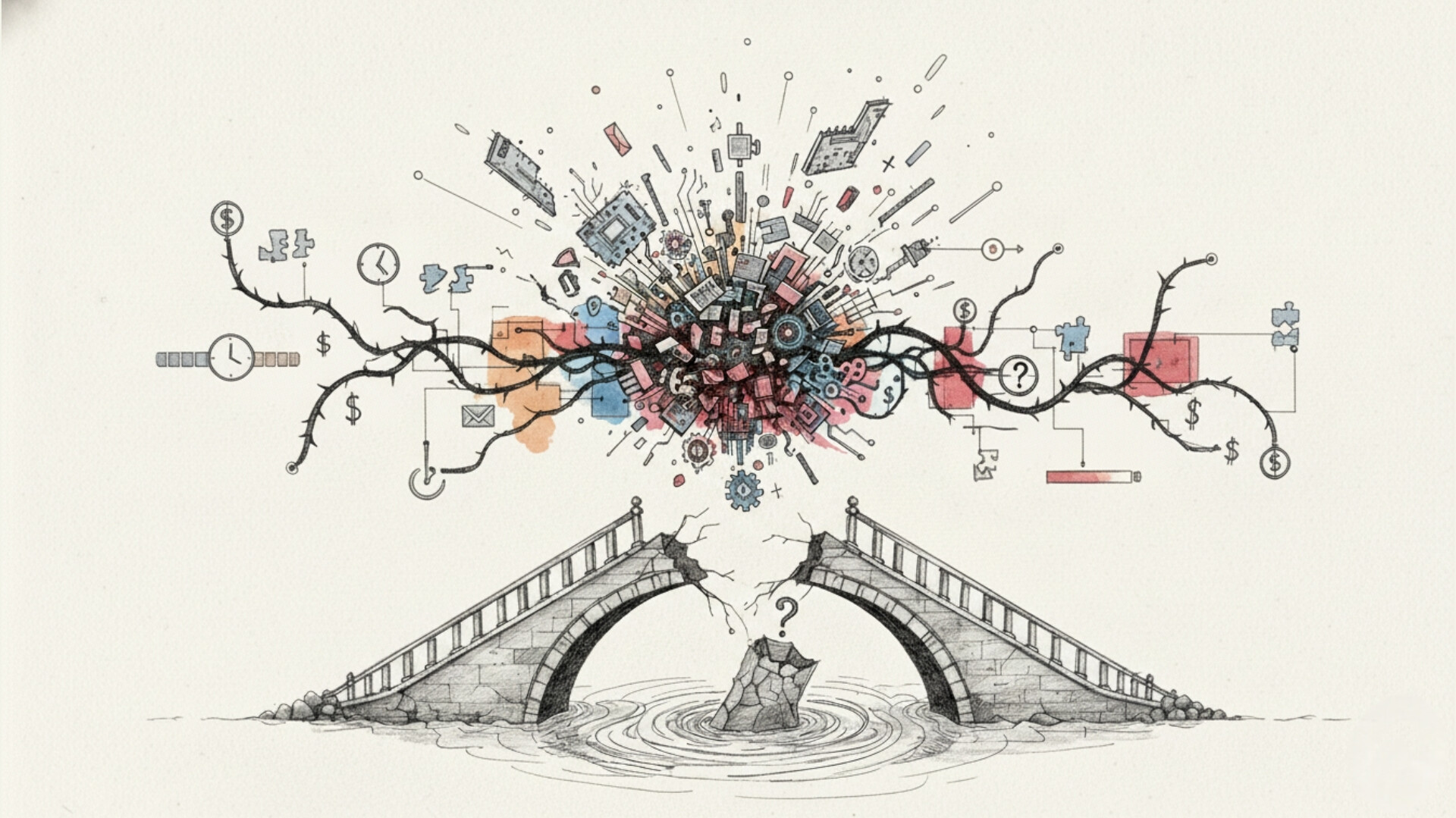AI Medical Scribe: The End of Clinical Paperwork
Discover how the AI medical scribe is ending physician burnout by automating clinical notes. Explore the benefits, costs, and how to choose the best solution.

Picture this: a sharp assistant who listens in on every patient visit, understands the nuances of the medical conversation, and instantly drafts the perfect clinical note. That's no longer science fiction; it's the reality of an AI medical scribe. This technology is designed to directly combat one of the biggest causes of physician burnout—the mountain of documentation.
What Is an AI Medical Scribe, Really?
At its core, an AI medical scribe is a sophisticated piece of software that uses artificial intelligence to listen to, interpret, and document conversations between clinicians and patients. It relies heavily on natural language processing (NLP) to make sense of human speech.
Instead of the doctor having to split their attention between the patient and the keyboard, the AI scribe works quietly in the background. This concept is often called "ambient AI." It actively captures the entire dialogue and translates it into structured, accurate clinical documentation, often populating the note directly within the electronic health record (EHR).
This is a world away from simple transcription services or manual data entry. The AI isn't just turning speech into text; it's understanding medical context, pulling out the relevant details, and ignoring the small talk. This simple change allows clinicians to put down the keyboard and give their undivided attention back to the patient. For any healthcare organization looking to operate more efficiently, these tools are a massive step forward, much like other game-changing AI solutions.
How It Works in the Exam Room
Think of the AI scribe as your digital partner during the consultation. It listens to the natural back-and-forth of the conversation and intelligently identifies the critical pieces of the puzzle:
- The patient’s main complaint and the story behind their current illness
- A review of systems and physical examination findings
- The physician's final assessment and proposed care plan
- Any orders for prescriptions, lab work, or imaging
The system then takes all this information and organizes it into a standard format, like a SOAP note, ready for the physician to quickly review and sign off. This is a perfect example of effective AI Automation as a Service, where smart technology takes over the tedious, repetitive work.
The impact can be staggering. A landmark study from The Permanente Medical Group revealed that ambient AI scribes saved their physicians a whopping 15,791 hours of documentation time in a single year. You can learn more about these significant time-saving findings directly from the source.
By automating the note-taking process, AI medical scribes deliver more than just time savings. They help restore the human connection at the heart of medicine, freeing doctors to be fully present with their patients instead of being glued to a screen.
When you get right down to it, this isn't just another shiny new tech tool. It represents a fundamental shift in how doctors can practice medicine. It turns complex, unstructured conversations into clean, usable data and, most importantly, allows providers to get back to what they were trained to do: care for patients. Building a plan to bring these tools into your organization is a critical next step, a process we guide our clients through with our AI strategy consulting.
From Conversation to Clinical Note
So, how does an AI scribe actually turn a normal, everyday conversation into a structured clinical note? It's a fascinating process that starts the second a clinician hits 'record.' The system begins capturing the audio from the exam room, but it's doing a lot more than just recording.
The first job is to convert all that spoken dialogue into text, which relies on some pretty sophisticated Voice to Text AI technology. Once the words are on the page, so to speak, the real magic begins.
Understanding the Context
This is where the "intelligence" in artificial intelligence really comes into play. The system uses advanced Natural Language Processing (NLP) to make sense of the transcribed conversation. It can tell the difference between the doctor speaking, the patient, and maybe even a family member in the room.
More importantly, it’s trained to understand medical context. The AI knows that when a patient says, "my tummy has been killing me for three days," the clinical note should read, "Chief Complaint: Abdominal pain, 3-day duration." It also knows to filter out the small talk about the weather or traffic, zeroing in only on what's clinically relevant. This ability to intelligently sift through conversation is what makes the final note so clean and focused.
This infographic paints a clear picture of how AI scribes can be a direct solution to the burnout so many physicians face from documentation overload.

As you can see, the technology isn't just a tool; it's a bridge that transforms a major administrative headache into a chance for physicians to reclaim their time and focus.
Generating the Final Note
After the AI has identified and sorted all the key pieces of information, it assembles everything into a structured clinical note. Most of the time, this follows a standard format clinicians know well, like SOAP (Subjective, Objective, Assessment, Plan).
Here’s how it breaks down the conversation:
- Subjective: This section captures the patient's story—their history and the symptoms they’re reporting.
- Objective: Here, it documents the physician's own observations and physical exam findings.
- Assessment: This part lists the final diagnosis or potential diagnoses.
- Plan: Finally, it outlines what’s next—prescriptions, lab orders, specialist referrals, or follow-up instructions.
This fully drafted note is then pushed directly into the clinic’s Electronic Health Record (EHR), where it waits for the clinician. All that's left for the doctor is to give it a quick review for accuracy, make any small edits, and sign off. It’s a workflow that saves an incredible amount of time and frees up mental energy that's far better spent on patient care.
AI Scribes vs. Human Scribes
Deciding between an AI medical scribe and a human one is a major crossroads for any healthcare practice. Both are meant to solve the same problem—freeing clinicians from the keyboard—but they get there in completely different ways, with distinct costs and capabilities. Getting this choice right means really understanding what makes them tick.
For years, human scribes were the only game in town. They bring a human touch into the exam room, capable of understanding nuance and adapting on the fly. But anyone who has managed a team of scribes knows the operational headache: high and recurring labor costs, the nightmare of scheduling, and the simple fact that people get tired and make mistakes. Trying to scale that model across a large clinic or hospital system is a massive financial and logistical undertaking.
This is where AI scribes change the conversation. Think of them as a consistent, scalable, and tireless alternative. They're on the clock 24/7—no breaks, no sick days, no scheduling conflicts. This reliability is a game-changer. An AI scribe follows the exact same documentation rules for every single patient encounter, which means you get incredible uniformity across thousands of clinical notes. This focus on dependable, scalable efficiency is the whole idea behind our AI Automation as a Service model.
Head-to-Head Comparison
To really see the trade-offs, it helps to put the two models side-by-side. The differences become pretty stark when you look at the day-to-day realities of running a practice.
Below is a table that breaks down the key operational and financial aspects of implementing AI-driven scribing solutions versus employing traditional human scribes.
| Feature | AI Medical Scribe | Human Scribe |
|---|---|---|
| Availability | 24/7, on-demand. Instantly available for every single appointment. | Limited by work schedules, availability, and inevitable absences. |
| Cost at Scale | Dramatically lower per-encounter cost. Scales up with minimal extra expense. | High recurring salary or hourly wages. Costs grow directly with every new hire. |
| Consistency | 100% consistent. Applies the same structure and rules to every note, every time. | Variable. Performance can dip due to fatigue, training gaps, or personal style. |
| EHR Integration | Deep, direct integration. Pushes notes and structured data right into the EHR. | Manual data entry. This is slower and opens the door to transcription errors. |
| Implementation Speed | Can be rolled out across an entire organization quickly after the initial setup. | A long cycle of recruiting, hiring, training, and onboarding for each person. |
| Data Security | Built on HIPAA-compliant platforms with end-to-end data encryption. | Adds more human access points to PHI, which naturally increases security risks. |
This comparison highlights how AI fundamentally re-engineers the scribing workflow, shifting it from a labor-intensive service to a streamlined, technology-driven utility.
Where Each Excels
In a straight race, an AI scribe wins on speed, cost-efficiency, and consistency, hands down. For any practice handling a high volume of patients, these advantages are huge. The ability to pipe documentation directly into the EHR, without a human having to touch it, is a massive operational victory.
That said, a human scribe can still be a great asset in highly complex specialties where patient conversations are all over the map and don't follow a predictable pattern. But for the overwhelming majority of day-to-day clinical encounters, the structured and ruthlessly efficient documentation from an AI scribe just makes more sense. The business case gets even stronger when you factor in the long-term ROI from slashing administrative overhead and boosting physician productivity.
The Real-World Impact on Healthcare

Beyond the technical jargon, the true test of an AI medical scribe is how it actually changes things for doctors, patients, and the entire hospital system. The effects start small but create big ripples, beginning with one simple gift: giving physicians back their time. We're often talking about up to two hours per day that was once completely consumed by administrative work.
This isn't just a minor convenience; it's a direct counter-punch to the epidemic of physician burnout. When doctors aren't drowning in paperwork, morale and job satisfaction get a much-needed boost. For a closer look at how tools like these lighten the load, these strategies for efficient dictation for doctors really break down the time savings and burnout reduction.
Boosting Operational and Clinical Efficiency
Once a clinician is free from their keyboard, they can finally work at the top of their license. The most immediate improvements show up in clinic throughput and how quickly documentation gets done.
- Increased Patient Capacity: Less time spent writing notes after each visit means doctors can often see more patients in a day. This helps shorten wait times and improve access to care for everyone.
- Faster Chart Closures: Imagine notes being ready for review just moments after a patient walks out the door. This speeds up the entire billing cycle and gets crucial clinical information into the hands of the next care provider much faster.
- Enhanced Note Accuracy: AI scribes don't get tired or distracted. They produce consistent, well-structured documentation, which cuts down on the human errors that can creep in at the end of a long shift. That precision is everything when it comes to patient safety.
This is about more than just speed. It’s about re-investing a doctor's most valuable asset—their clinical expertise—back into patient care instead of clerical tasks. The end result is a more resilient and effective healthcare system.
The Financial and Quality-of-Care Connection
The benefits don't stop at the clinic door; they extend straight to the organization's bottom line and quality metrics. When clinical notes are more accurate and detailed, they provide a much stronger justification for billing codes. This means better revenue capture and fewer frustrating claim denials. Plus, that meticulous documentation helps keep everything compliant with regulatory standards.
There's a human side to this, too. Better patient-provider interactions lead to higher patient satisfaction scores, like HCAHPS (Hospital Consumer Assessment of Healthcare Providers and Systems). When a doctor can maintain eye contact and have a real conversation instead of staring at a screen, patients feel heard and valued. That connection is a cornerstone of our work in the healthcare industry.
The market is clearly taking notice. The demand for AI medical scribes has exploded, with the ambient scribe market alone pulling in an estimated $600 million in recent revenue—a massive 2.4x increase year-over-year. This surge is led by companies like Nuance’s DAX Copilot (holding 33% of the market) and Abridge (30%), who are answering the desperate need to slash the documentation burden.
How to Successfully Implement an AI Scribe

Bringing an AI medical scribe into your practice is more than just a software install. It’s a fundamental change to your clinical workflow, and getting it right from the start takes a clear, deliberate plan. It all begins with a solid technical foundation, ensuring the new tool can talk to your existing systems without a hitch.
The first make-or-break point is deep EHR integration. Think about it: if an AI scribe can’t push its notes directly and accurately into your electronic health record, it’s not saving time—it’s just creating another task. The whole point is to eliminate that manual data entry. This is where careful planning, often guided by an expert AI implementation support team, can make all the difference between a smooth rollout and a frustrating one.
Getting Your Team On Board
Once the tech is wired up correctly, your focus needs to pivot to the people who will be using it every day: your doctors. Training isn't about teaching them complex software. It's really about building trust and good habits. Most ambient AI scribes are designed to be simple, but clinicians still need to learn the best way to review and sign off on notes quickly. They also need to be coached on speaking clearly and naturally so the AI can do its job effectively.
At the same time, you have to lock down security and compliance—this is absolutely non-negotiable. Any AI scribe you consider must be fully HIPAA compliant, using strong end-to-end encryption for all patient data. Before you sign anything, get a Business Associate Agreement (BAA) in hand and do your homework on the vendor's security measures. This is how you protect patient privacy while bringing in a powerful new tool.
Start Smart with a Pilot Program
Instead of flipping the switch for everyone at once, a pilot program is always the best way to begin. This lets you test the AI scribe in a real-world but controlled setting, gather honest feedback, and prove its value before going organization-wide. A thoughtful change management plan is crucial for getting everyone on board.
To know if your pilot is actually working, you need to set clear Key Performance Indicators (KPIs) from day one.
- Documentation Time: How long does it take your doctors to finish notes before and after using the AI scribe?
- Chart Closure Rates: Are notes being finalized and signed off on faster than before?
- Physician Satisfaction: Send out simple surveys. Are your clinicians feeling less burned out? Do they find the tool easy to use?
- Note Accuracy: Perform regular chart audits. Do the AI-generated notes meet your quality and compliance standards?
This kind of data-driven approach doesn't just demonstrate the return on investment; it gives you the insights needed to fine-tune your full-scale rollout. A great pilot creates champions for the new technology and builds real momentum for the positive changes ahead.
Picking the Right AI Scribe for Your Practice
Let's be clear: not all AI medical scribes are created equal. Choosing the right one is a make-or-break decision for your practice, so you need to look past the slick marketing materials and focus on what really matters in a busy clinical setting.
The first, and arguably most important, test is specialty-specific accuracy. A one-size-fits-all AI simply won't work. The system has to understand the unique language of your field, whether that's the subtle nuances of a cardiology consult or the specific terminology used in dermatology. The best tools, like the Clinic AI Assistant, are trained on massive datasets tailored to specific medical specialties, ensuring the notes it produces are both precise and clinically relevant from day one.
What to Look for When Comparing Vendors
Next on the list is EHR integration. This is non-negotiable. The whole point of an AI scribe is to save time, and if your team has to manually copy and paste notes into the electronic health record, you’ve just traded one tedious task for another. Insist on a live demo that shows you exactly how the tool communicates with your specific EHR system.
As you evaluate different solutions, keep these critical questions in mind:
- Integration Depth: Does the tool just dump a block of text into the EHR, or can it intelligently populate discrete, structured data fields? This makes a huge difference for billing and reporting.
- Pricing Model: What's the cost structure? Is it a flat monthly fee per provider, a charge per patient encounter, or something else entirely? Make sure the model makes financial sense for your patient volume and budget.
- Data Security: How are you protecting my patients' data? The vendor absolutely must be HIPAA compliant and ready to sign a Business Associate Agreement (BAA). Don't even consider a solution that can't provide this.
- Support & Training: What happens after you sign the contract? Ask about the onboarding process and what kind of support is available when you run into inevitable technical glitches.
Taking the time to dig into these details will empower you to run a much more effective pilot program and choose a partner that truly understands the demands of modern healthcare.
Common Questions About AI Medical Scribes
Whenever you introduce a new tool into clinical workflows, a healthy dose of skepticism and a lot of questions are bound to follow. That’s a good thing. Getting clear on the details is the only way to make a smart decision for your organization. Let's tackle some of the most common questions we hear from healthcare leaders.
How Accurate Are AI Scribes?
This is usually the first question on everyone's mind, and for good reason. Top-tier AI medical scribes now reach accuracy rates above 98%. In many cases, this level of precision actually surpasses human scribes by maintaining perfect consistency and avoiding the kinds of errors that creep in due to simple fatigue.
The secret sauce is the training data. The best platforms are built on millions of de-identified patient encounters, which teaches the AI to grasp complex medical jargon, parse different accents, and understand the natural, back-and-forth flow of a conversation. While a quick clinician review is still part of the workflow, the AI handles the overwhelming majority of the work with impressive reliability.
Is Patient Data Secure and HIPAA Compliant?
Absolutely. Any AI scribe vendor worth considering has built their platform from the ground up to be HIPAA-compliant. This isn't just a feature; it's a foundational requirement.
They use end-to-end encryption for all data, whether it's being captured or stored. To add another layer of protection, patient information is typically de-identified during processing. Before you even think about signing a contract, you must verify the vendor's security certifications and have a signed Business Associate Agreement (BAA) in place.
The market growth reflects this trust in secure technology. The U.S. medical transcription industry is on track to become a $3.3 billion market, growing at a steady 5% each year, which speaks volumes about the demand for these tools. You can explore more market trends and statistics to get a better sense of where the industry is heading.
What Is the Training and Onboarding Process?
You’ll be pleasantly surprised. The training commitment for clinicians is incredibly light. Most of today's ambient AI scribes are designed to be "invisible," running quietly in the background without getting in the way of the patient-doctor conversation.
The onboarding process usually boils down to a single session—often under an hour. The goal is simply to walk clinicians through the final step: how to quickly review, make any minor edits, and sign off on the AI-generated notes right inside the EHR. It’s more about familiarization than intensive training.
Making the move to AI-powered documentation is a big step, but you don't have to go it alone. If you're looking for guidance, our expert team can help you navigate everything from picking the right vendor to ensuring a smooth rollout.
Frequently Asked Questions (FAQ)
Q1: What is an AI medical scribe?
An AI medical scribe is a software tool that uses artificial intelligence, specifically natural language processing (NLP), to listen to doctor-patient conversations and automatically generate clinical documentation. It captures the relevant medical information and structures it into a standard note format within the electronic health record (EHR).
Q2: How does an AI medical scribe differ from a human scribe?
While both aim to reduce documentation burden, an AI scribe is a technology solution that is available 24/7, highly scalable, and offers consistent note quality. A human scribe is a person who physically or virtually accompanies a clinician. AI scribes generally have a lower cost at scale, integrate directly with EHRs, and eliminate the logistical challenges of managing staff.
Q3: Is the data captured by an AI medical scribe secure?
Yes, reputable AI medical scribe vendors build their platforms to be fully HIPAA compliant. They use end-to-end encryption for all audio and text data, operate under Business Associate Agreements (BAAs), and often de-identify patient information during processing to ensure maximum privacy and security.
Q4: How much time can an AI medical scribe save a physician?
Studies and real-world usage show that AI medical scribes can save physicians up to two hours per day on administrative tasks. This significant time savings helps reduce physician burnout, allows for more patient-facing time, and improves overall job satisfaction.
Q5: What is required to implement an AI scribe in my clinic?
Successful implementation requires choosing a vendor with deep EHR integration capabilities, ensuring the platform is HIPAA compliant, and conducting a pilot program to test the workflow. Training for clinicians is minimal, typically focusing on how to review and approve the AI-generated notes efficiently.



